In today’s data-driven world, businesses rely heavily on effective data management and analysis to make informed decisions. A crucial component of this process is the extraction, transformation, and loading (ETL) of data into a data warehouse. ETL is the foundation upon which data warehouses are built, enabling businesses to consolidate and analyze large volumes of structured and unstructured data. Traditional data warehouse ETL processes have been used for years, but recently, a new player has emerged in the market: Snowflake. In this article, we will conduct a comparative analysis of Snowflake and traditional data warehouse ETL, exploring their key differences and benefits.
Understanding Data Warehouse ETL
Data Warehouse ETL refers to the process of extracting data from various sources, transforming it into a consistent format, and loading it into a data warehouse for analysis and reporting purposes. Traditional ETL processes involve complex and time-consuming operations, including data extraction from source systems, data cleansing and transformation, and the loading of transformed data into a centralized data warehouse.
Snowflake Architecture: A Revolutionary Approach
Snowflake, on the other hand, takes a revolutionary approach to data warehousing. It is built on a cloud-native architecture that separates storage and compute, allowing businesses to scale resources independently based on their needs. With Snowflake Architecture, data is stored in a columnar format, enabling efficient compression and faster query performance. Moreover, Snowflake’s architecture supports automatic data indexing, reducing the need for manual indexing and improving query optimization.
Comparing Performance and Scalability
One of the key advantages of Snowflake over traditional data warehouse ETL is its performance and scalability. Traditional ETL processes often suffer from performance bottlenecks and limitations when dealing with large datasets. Snowflake, with its elastic scaling capabilities, can handle massive volumes of data and effortlessly scale up or down based on demand. This scalability ensures that businesses can process and analyze data without compromising performance.
Data Transformation and Complexity
Data transformation is an essential aspect of ETL processes, as it involves standardizing and structuring data for analysis. Traditional ETL requires extensive coding and complex scripting to transform data, which can be time-consuming and error-prone. In contrast, Snowflake simplifies the data transformation process with its built-in functions and SQL support. It provides a comprehensive set of transformation capabilities, including filtering, aggregation, and joining, making it easier for data engineers and analysts to transform data efficiently.
Ease of Use and Management
Managing and maintaining a traditional data warehouse ETL infrastructure can be challenging and resource-intensive. It often requires dedicated IT resources to monitor and optimize the system’s performance. Snowflake, being a cloud-based platform, takes away the burden of infrastructure management. It offers a user-friendly interface and intuitive tools that simplify management and administration tasks, allowing businesses to focus on analyzing and deriving insights from their data.
Data Security and Compliance
Data security and compliance are critical concerns for any organization dealing with sensitive data. Traditional data warehouse ETL processes may require additional measures and investments to ensure data security, such as encryption and access control mechanisms. Snowflake, as a cloud data platform, offers robust security features built into its architecture. It provides end-to-end encryption, fine-grained access control, and compliance certifications, ensuring data privacy and regulatory compliance.
Cost Considerations
Cost is an important factor when evaluating data warehouse ETL solutions. Traditional ETL processes often involve substantial upfront costs for hardware, software licenses, and infrastructure setup. Additionally, ongoing maintenance and upgrade expenses can add up over time. Snowflake, with its pay-as-you-go pricing model, offers a more cost-effective alternative. Businesses can scale their resources as needed and only pay for the actual usage, resulting in potential cost savings.
Enhanced Data Sharing and Collaboration
Another key advantage of Snowflake is its data-sharing and collaboration capabilities. With traditional data warehouse ETL, sharing data with external parties can be complex and time-consuming. In contrast, Snowflake allows organizations to securely share data with partners, customers, or third-party applications in a controlled and granular manner. This enables seamless collaboration and data-driven decision-making across the ecosystem.
Considerations for Migration
For organizations considering migrating from traditional data warehouse ETL to Snowflake, there are a few key considerations. Firstly, it is important to evaluate the existing ETL processes and determine how they can be redesigned to leverage Snowflake’s capabilities effectively. Additionally, data migration and integration strategies should be carefully planned to ensure a smooth transition without disrupting ongoing operations.
Conclusion
The evolution of cloud computing and modern data warehousing has brought about significant changes in the world of ETL. While traditional data warehouse ETL processes have served organizations well for many years, Snowflake’s architecture and capabilities provide a compelling alternative. With its performance, scalability, ease of use, and robust security features, Snowflake offers a modern approach to data warehouse ETL that empowers businesses to unlock the true potential of their data. As organizations continue to embrace the power of data analytics, understanding the differences between Snowflake and traditional ETL becomes essential for making informed decisions about their data management strategies.



